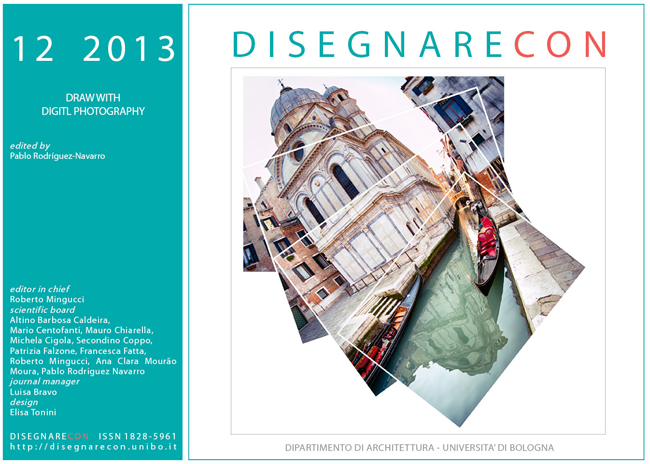Existential space understanding through digital image
DOI:
https://doi.org/10.6092/issn.1828-5961/3855Keywords:
Digital image, spatial perception, ArchitectureAbstract
The logical way to learn from the architectural space and then be able to design and represent it is, undoubtedly, that of experiencing it through all the sensitive channels that the space wakes up us. But since the last 30 years, much of our learning about space comes from images of architecture and not from the space itself. The art of architecture is drifting towards a visual art and moving away from its existential side. In digital images that have flooded the architectural media, digital photographs of existing spaces intermingle with non-existent space renderings (photographs with a virtual camera). The first ones represent existing places but can be altered to change the perception that the observer of the image will have, the second ones speak to us about places that do not exist yet but they present reality portions through extracts from digital photography (textures, trees, people...) that compose the image.
References
Aumont, J. (1992) La imagen, Paidos, Barcelona.
Appleyard, D. (1977) Understanding professional media: issues, theory, and a research agenda in I Altman and J F Wohlwill (eds) Human behavior and environment Vol 2 Plenum Press, New York, pp. 43–88
Bates-Brkljac, N., (2008) Assessing perceived credibility of traditional and computer generated architectural representations, in Design Studies, 30 (4), pp. 415-417.
Bergen, S. D., Ulbricht, C. A., Fridley, J. L. & Ganter, M. A. (1995) The validity of computer-generated graphic images of forest landscapes, in Journal of Environmental Psychology, 15, pp. 35-146.
Bishop, I.D., Ye, W-S., & Karadaglis, C. (2001) Experiental approaches to perception response in virtual worlds, in Landscape and Urban Planning, 54, pp. 115-123.
Daniel, T.C., Meitner, M., M., (2001) Representational validity of landscape visualizations: The effects of graphical realism on perceived scenic beauty of forest vistas, in Journal of Environment Psychology, 21, pp. 61-62.
Bishop, I.D.& and Rohrmann, B. (2003). Subjective responses to simulated and real environments: a comparison, in Landscape and Urban Planning, 65, pp. 261-277.
De Kort, Y.A.W., IJsselsteijn, W.A., Kooijman, J., & Schuurmans, Y. (2003) Virtual laboratories: Comparability of real and virtual environments for environmental psychology, in Presence, Teleoperators and Virtual Environments, 12 (4), pp. 360-373.
Ehrenzweig, A. (1976) Psicoanálisis de la percepción artística. Gustavo Gili. Barcelona.
Houtkamp, J.M. (2004) Affective appraisal as a requirement for 3D models:a systematic
Approach, in ACM International Conference Proceeding Series, Proceedings of the conference on Dutch directions in HCI.
Lang, P., (1968) Fear reduction and fear behaviour: problems in treating a construct, Research in Psychology, Vol 3, pp. 90-103.
Lange, E. (2001) The limits of realism: perception of virtual landscapes, in Landscape and Urban Planning, 55, pp. 163-182.
Lang, P., Bradley, M., & Cuthbert, B. (1997) International Affective Picture System (IAPS): Technical Manual and Affective Ratings. Gainesville, Florida.
Leonard, M., (1969). Humanizing Space, in Architectural Forum.
Milgram, P., Kishino, F. (1994) A taxonomy of mixed reality visual displays in IEICE Transactions on Information Systems, Vol E77-D, Nº 12.
Nasar, J. (1994) Urban design aesthetics: The evaluative qualities of building exteriors in Environment and Behaviour, 26 (3), pp. 377-401.
Norberg-Shulz, C. (1975) Existencia, Espacio y Arquitectura. Editorial Blume. Barcelona.
Pallasmaa, J., (2006) Los Ojos de la piel. Gustavo Gili. Barcelona.
Piaget, J (1966) Psicología de la Inteligencia. Editorial Psique. Buenos Aires.
Radford, A., Woodbury, R., Braithwaite, G., Kirkby, S., Sweeting, R., Huang, E. (1997) Issues of abstraction, accuracy and realism in large scale computer urban models, in CAAD. Futures Digital Proceedings, pp. 679-690
Rohrmann, B., Bishop, I. (2002) Subjective responses to computer simulations of urban environments in Journal of Environmental Psychology, 22(4), pp. 319-331.
Sheppard, S., (1989) Visual simulations, a user’s guide for architects, engineers and planners, Van Nostrand Reinhold, New York.
Westerdahl, B., Suneson, K., Wernemyr, C., Roupé, M., Johansson, M., Allwood, C.M. (2006) Users evaluation of a virtual reality architectural model compared with the experience of the completed building, in Automation in Construction, 15, pp. 150-165.
Downloads
Published
How to Cite
Issue
Section
License
Copyright (c) 2013 Susana Iñarra Abad, Francisco Juan Vidal





